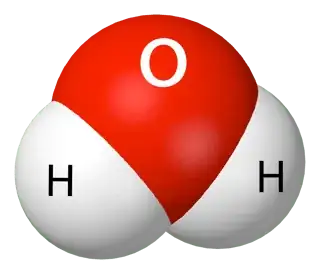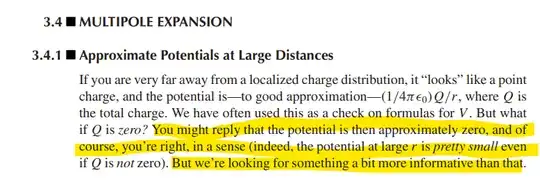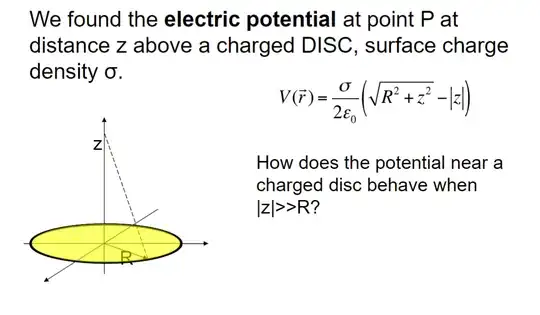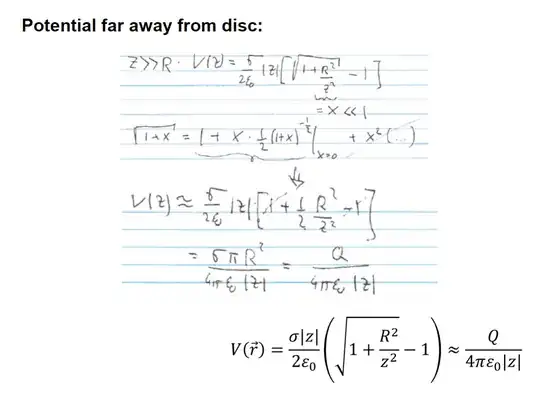What does the electric potential of a water molecule look like?

Imagine a cartoon picture of a water molecule, in which the oxygen atom has charge $-2q$ and sits at the origin and the hydrogen atoms each have charge $q$ and sit at $x=\pm d\cos(\theta), y=0, z=-d\sin(\theta)$ with $d\approx 94$ pm and $\theta \approx 52.2^\circ$. What does the electric potential look like at distances very large compared to $d$?
Your question suggests that your response would be "the potential is basically zero." That is extremely unhelpful, however, if I asked my question with the intent of understanding how water molecules interact with one another. Those interactions may or may not be particularly strong, but if I want to understand the nature of them then I need something to work with.
"Aha!" You say, "I can simply write down the answer:"
$$ V(x,y,z) = -\frac{2q}{4\pi \epsilon_0 \sqrt{x^2+y^2+z^2}}+ \frac{q}{4\pi\epsilon_0\sqrt{(x-d\cos(\theta))^2+y^2+(z+d\sin(\theta))^2}}+ \frac{q}{4\pi\epsilon_0\sqrt{(x+d\cos(\theta))^2+y^2+(z+d\sin(\theta))^2}}\tag{$\star$}$$
Okay, fair enough. So now, can you tell me how one water molecule interacts with another? Can you compute, for example, the torque that this water molecule applies to another which is located at some other position in a different orientation? In principle, sure. But it's going to be messy, and tedious, and not particularly illuminating.
Is there a better solution? From your time sitting in calculus classes, you may realize that you could approximate these results assuming that $d$ is small. This might provide a nearly equivalent answer which is far simpler to write down, and gives you vastly more insight into the behavior of water molecules.
In particular, notice that
$$(x\pm d\cos(\theta)^2+y^2+(z+d\sin(\theta))^2 = x^2+y^2+z^2 \pm 2xd\cos(\theta)+2zd\sin(\theta) + d^2$$
$$\equiv r^2\left(1 \pm \frac{2xd}{r^2}\cos(\theta) + \frac{2zd}{r^2}\sin(\theta) + \frac{d^2}{r^2}\right)$$
Taking the square root and computing the reciprocal yields
$$\frac{1}{r}\left(1 \mp \frac{xd}{r^2}\cos(\theta) - \frac{zd}{r^2}\sin(\theta)\right)$$
where we have approximated $(1+ \ldots)^{-1/2}$ and neglected $d^2/r^2$, which we take to be far smaller than the terms we have kept. Applying this approximation to each term in the nightmare above yields the following:
$$V(x,y,z) \approx -\frac{2q}{4\pi\epsilon_0 r} + \frac{q}{4\pi\epsilon_0 r}\left(1- \frac{xd}{r^2}\cos(\theta) - \frac{zd}{r^2}\sin(\theta)\right)$$
$$+\frac{q}{4\pi\epsilon_0 r}\left(1 + \frac{xd}{r^2}\cos(\theta) - \frac{zd}{r^2}\sin(\theta)\right)$$
$$= \frac{(-2q + q + q)}{4\pi \epsilon_0 r} - \frac{2qzd\sin(\theta)}{4\pi \epsilon_0 r^3}$$
Hopefully you agree that this is a vast improvement in clarity. Things are improved further by noting that the first term cancels out because the total charge of the molecule is $-2q+q+q=0$, leaving
$$V(x,y,z)\approx \frac{\mathbf p \cdot \mathbf r}{4\pi \epsilon_0 r^3}\tag{$\star\star$}$$
where $\mathbf p \equiv -(2q)d\sin(\theta) \hat z$ is the molecule's dipole moment. I'm sure you will agree that $(\star\star)$ is vastly preferable to $(\star)$ both in conceptual clarity and computational efficiency - and for $d\ll r$, the difference between them is a small fraction of a percent.
What we've actually done is compute the first two terms of the multipole expansion, which formalizes what we did by hand and makes it very efficient. The monopole contribution vanishes because the net charge is zero, but the dipole moment is nonzero and so the second term in the expansion survives (as do others, but they are much smaller at large distances). We can now use it to answer my questions from before:
Can you compute, for example, the torque that this water molecule applies to another which is located at some other position in a different orientation?
Sure. The electric field due to the dipole is
$$\mathbf E = -\nabla V = -\frac{\mathbf p}{4\pi\epsilon_0r^3} + \frac{3(\mathbf p \cdot \mathbf r)\mathbf r}{4\pi \epsilon_0 r^5}$$
(have fun calculating that for $(\star)$). An elementary result tells us that the torque on a second dipole $\mathbf p'$ is
$$\boldsymbol{\tau} = \mathbf p' \times \mathbf E = -\frac{\mathbf p'\times \mathbf p}{4\pi \epsilon_0 r^3} + \frac{3(\mathbf p\cdot \mathbf r)(\mathbf p' \times \mathbf r)}{4\pi \epsilon_0 r^5}$$
can you tell me how one water molecule interacts with another?
Each water molecule creates an approximate dipole field, and other molecules feel a torque which encourages them to align with that dipole field. Two isolated water molecules will therefore seek to align with one another (this is part of hydrogen bonding), and networks of water molecules will assume a configuration which most effectively aligns them with one another (which results in the crystalline structure of ice).



